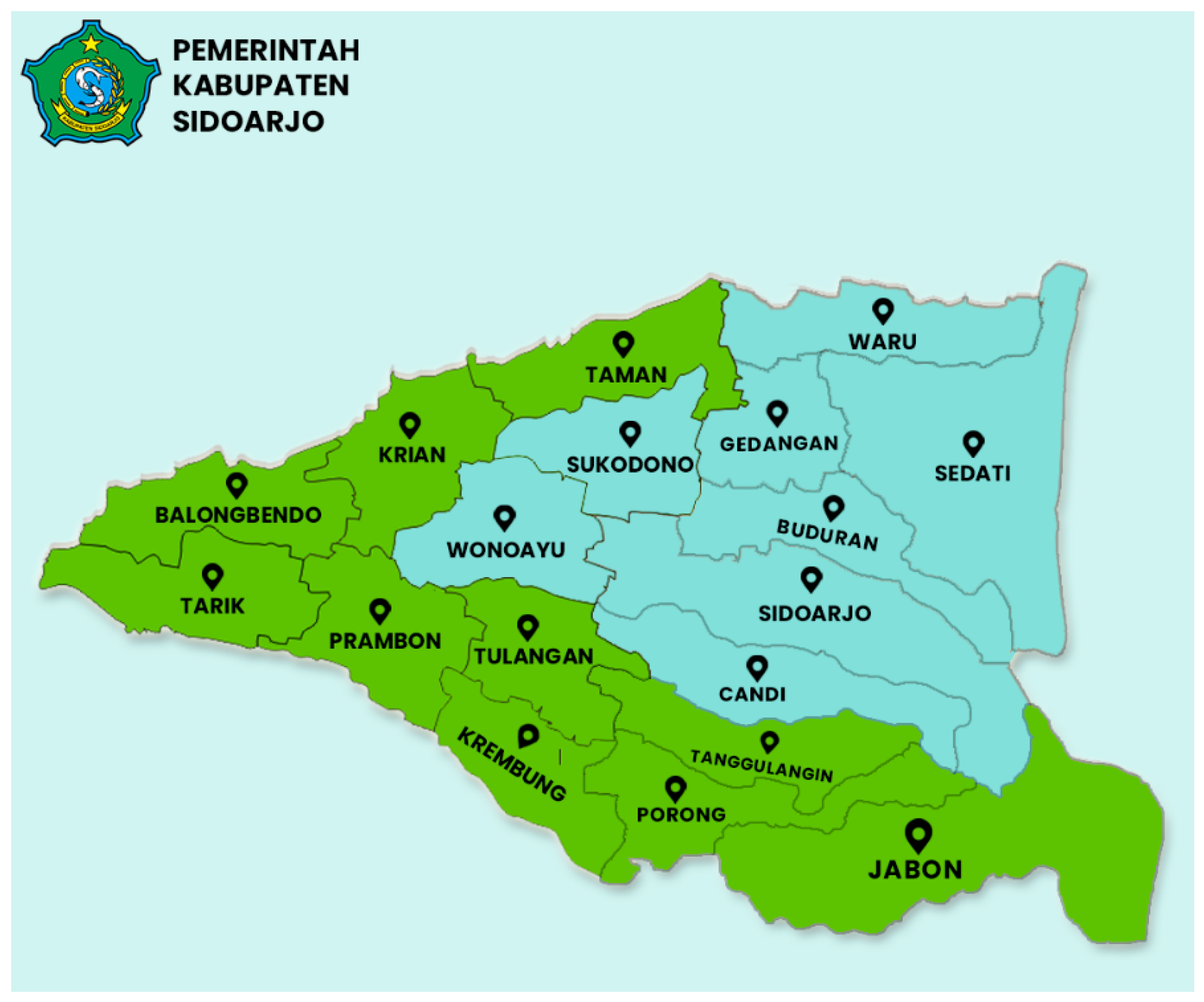Seeking the Opportunities and Challenges of Blue Economy Sustainable Development: A Case Study of Sidoarjo, Indonesia †
Abstract
:1. Introduction
2. Materials and Methods
3. Results
3.1. Developing the Blue Economy
3.1.1. Captured Fisheries Sub-Sector
3.1.2. Aquaculture Sub-Sector
3.1.3. Fishery Product Processing and Marketing Sub-Sector
3.2. SWOT Analysis
3.3. Discussion
Author Contributions
Funding
Institutional Review Board Statement
Informed Consent Statement
Data Availability Statement
Conflicts of Interest
References
- Organisation for Economic Co-Operation and Development (OECD). The Ocean Economy in 2030; IWA Publishing: London, UK, 2017. [Google Scholar] [CrossRef]
- Harlis, S.; Nugroho, M.; Halik, A. Developing a Blue Economy in Depok West Java, Indonesia: Opportunities and Challenges of Neon Tetra Fish Cultivation. 2022. Available online: https://www.preprints.org/manuscript/202208.0357/download/fina l_file (accessed on 24 November 2022).
- Perissi, I.; Bardi, U.; El Asmar, T.; Lavacchi, A. Dynamic patterns of overexploitation in fisheries. Ecol. Model. 2017, 359, 285–292. [Google Scholar] [CrossRef] [PubMed]
- Sari, D.A.A.; Muslimah, S. Blue economy policy for sustainable fisheries in Indonesia. IOP Conf. Series: Earth Environ. Sci. 2020, 423, 012051. [Google Scholar] [CrossRef]
- United Nations. Transforming Our World: The 2030 Agenda for Sustainable Development. New Era Glob. Health 2018, A/RES/70/1, 26. [Google Scholar] [CrossRef]
- Maini, H.K.; Budhraja, L. Ocean based Blue Economy: An Insight into the SAGAR as the Last Growth Frontier; Semantic Scholar: Seattle, DC, USA, 2012. [Google Scholar]
- World Bank and United Nations Department of Economic and Social Affairs. The Potential of the Blue Economy: Increasing Longterm Benefits of the Sustainable Use of Marine Resources for Small Island Developing States and Coastal Least Developed Countries; World Bank: Washington, DC, USA, 2017. [Google Scholar]
- Lee, K.-H.; Noh, J.; Khim, J.S. The Blue Economy and the United Nations’ sustainable development goals: Challenges and opportunities. Environ. Int. 2020, 137, 105528. [Google Scholar] [CrossRef] [PubMed]
- Cisneros-Montemayor, A.M.; Moreno-Báez, M.; Voyer, M.; Allison, E.H.; Cheung, W.W.; Hessing-Lewis, M.; Oyinlola, M.A.; Singh, G.G.; Swartz, W.; Ota, Y. Social equity and benefits as the nexus of a transformative Blue Economy: A sectoral review of implications. Mar. Policy 2019, 109, 103702. [Google Scholar] [CrossRef]
- Bennett, N.J.; Villasante, S.; Espinosa-Romero, M.J.; Lopes, P.F.; Selim, S.A.; Allison, E.H. Social sustainability and equity in the blue economy. One Earth 2022, 5, 964–968. [Google Scholar] [CrossRef]
- Mahardianingtyas, S.; Safitra, D.A.; Agustio, A. A Blue Economy for Better Economic Development: A Case Study of East Nusa Tenggara, Indonesia. In Proceedings of the Asia Pacific Business and Economics Conference (APBEC 2018), Port Moresby, Papua New Guinea, 17–18 November 2018. [Google Scholar] [CrossRef] [Green Version]
- Menteri Kelautan dan Perikanan Republik Indonesia. Estimasi Potensi, Jumlah Tangkapan Yang Diperbolehkan, dan Tingkat Pemanfaatan Sumber daya ikan di Wilayah Perikanan Negara Republik Pengelolaan Indonesia; Menteri Kelautan dan Perikanan Republik Indonesia: Central Jakarta, Indonesia, 2017. [Google Scholar]
- LIPI Lembaga Ilmu Pengetahuan Indonesia. The Status of Indonesian Coral Reefs 2019; LIPI Lembaga Ilmu Pengetahuan Indonesia: Jakarta, Indonesia, 2020. [Google Scholar]
- McIlgorm, A.K.R.; McIlgorm, D.E. Update of 2009 APEC report on Economic Costs of Marine Debris to APEC Economies; University of Wollongong: Wollongong, Australia, 2020. [Google Scholar]
- Pauli, G.A. The Blue Economy: 10 Years, 100 Innovations, 100 million Jobs, 1st ed.; Paradigm Publications: Taos, New Mexico, 2010. [Google Scholar]
- Badan Pusat Statistik Sidoarjo. Kabupaten Sidoarjo Dalam Angka; Badan Pusat Statistik Sidoarjo: Sidoarjo, Indonesia, 2017. [Google Scholar]
- Badan Pusat Statistik Sidoarjo. Kabupaten Sidoarjo Dalam Angka; Badan Pusat Statistik Sidoarjo: Sidoarjo, Indonesia, 2018. [Google Scholar]
- Supriyati, M.; Anik. Industrialisasi Pertambakkan Kabupaten Sidoarjo Sebagai Upaya Peningkatan Kemakmuran Masyarakat. J. Pengabdi. LPPM Untag Surabaya 2017, 2, 26–32. [Google Scholar]
- Badan Pusat Statistik Sidoarjo. Kabupaten Sidoarjo Dalam Angka; Badan Pusat Statistik Sidoarjo: Sidoarjo, Indonesia, 2020. [Google Scholar]
- Wijaya, A. Bandeng Sidoarjo. Available online: https://blogs.uajy.ac.id/andiewijaya/2017/02/20/bandengsidoarjo/ (accessed on 28 February 2019).

| Opportunity | Strategy S-O | Strategy W-O |
|---|---|---|
|
|
|
| Threat | Strategy S-T | Strategy W-T |
|
|
|
Disclaimer/Publisher’s Note: The statements, opinions and data contained in all publications are solely those of the individual author(s) and contributor(s) and not of MDPI and/or the editor(s). MDPI and/or the editor(s) disclaim responsibility for any injury to people or property resulting from any ideas, methods, instructions or products referred to in the content. |
© 2022 by the authors. Licensee MDPI, Basel, Switzerland. This article is an open access article distributed under the terms and conditions of the Creative Commons Attribution (CC BY) license (https://creativecommons.org/licenses/by/4.0/).
Share and Cite
Putri, V.Y.; Janice, S.N.; Ramdhan Azzahra, T. Seeking the Opportunities and Challenges of Blue Economy Sustainable Development: A Case Study of Sidoarjo, Indonesia. Proceedings 2022, 83, 16. https://doi.org/10.3390/proceedings2022083016
Putri VY, Janice SN, Ramdhan Azzahra T. Seeking the Opportunities and Challenges of Blue Economy Sustainable Development: A Case Study of Sidoarjo, Indonesia. Proceedings. 2022; 83(1):16. https://doi.org/10.3390/proceedings2022083016
Chicago/Turabian StylePutri, Vindaniar Yuristamanda, Stephanie Nuriani Janice, and Tiara Ramdhan Azzahra. 2022. "Seeking the Opportunities and Challenges of Blue Economy Sustainable Development: A Case Study of Sidoarjo, Indonesia" Proceedings 83, no. 1: 16. https://doi.org/10.3390/proceedings2022083016
APA StylePutri, V. Y., Janice, S. N., & Ramdhan Azzahra, T. (2022). Seeking the Opportunities and Challenges of Blue Economy Sustainable Development: A Case Study of Sidoarjo, Indonesia. Proceedings, 83(1), 16. https://doi.org/10.3390/proceedings2022083016






